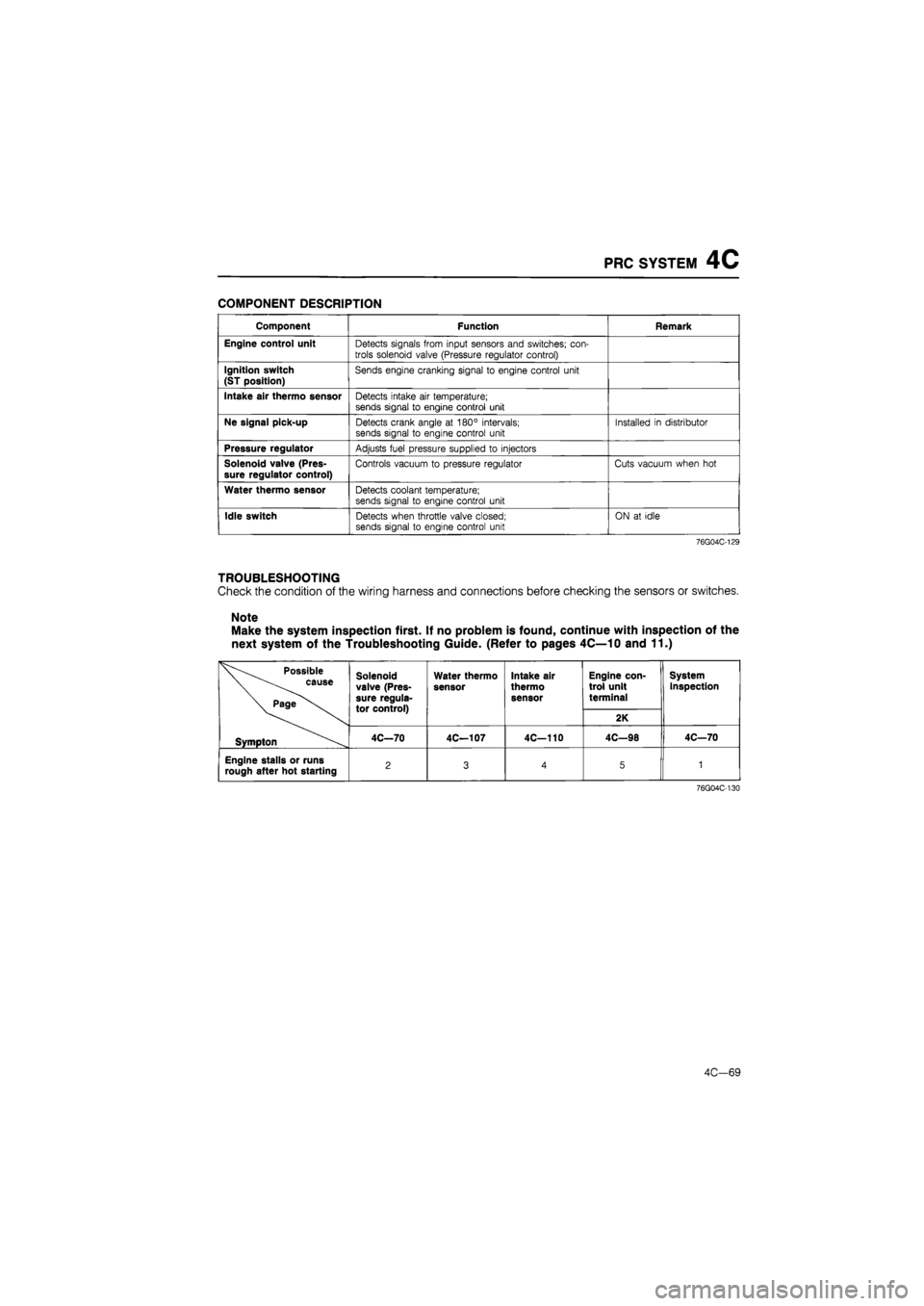check engine MAZDA 626 1987 Workshop Manual
[x] Cancel search | Manufacturer: MAZDA, Model Year: 1987, Model line: 626, Model: MAZDA 626 1987Pages: 1865, PDF Size: 94.35 MB
Page 607 of 1865

4C
ISC
SYSTEM
TROUBLESHOOTING
Check the condition of the wiring harness and connectors before checking the sensors or switches.
Note
Make the system inspection first. If no problem is found, continue with inspection of the
next system of the Troubleshooting Guide. (Refer to pages 4C—10 and 11.)
Possible cause
\Page
Symptom
Air valve P/S pres-sure switch
Solenoid
valve (Idle
speed
control)
Water
thermo
sensor
Engine control unit terminal System
In-
spection
Possible cause
\Page
Symptom
Air valve P/S pres-sure switch
Solenoid
valve (Idle
speed
control)
Water
thermo
sensor
1L 1W 2Q
System
In-
spection
Possible cause
\Page
Symptom 4C—47 4C—97 4C—48 4C—107 4C—98 4C—46
Engine
stalls
During warm up 2 — 3 4 — 5 6 1 Engine
stalls After warm up — 4 2 — 3 5 6 1
Rough
idle
During warm up 2 — 3 — — 4 5 1 Rough
idle After warm up 4 2 — 3 5 6 1
High idle speed after warm up 2 5 3 — 4 6 7 1
Runs rough on deceleration — — 2 — — 3 4 1
Afterburn in exhaust system 2 — 3 — — 4 5 1
Falls emission test 2 3 — — 4 5 1
76g04c-079
System Inspection
(Air valve)
1. Ground the test connector (Green, 1-pin) with a
jumper wire.
2. Disconnect the ISC valve connector (Gray, 2-pin)
at idle while the engine is cold.
3. Note the engine speed and reconnect the con-
nector.
4. Warm up the engine to the normal operating tem-
perature and disconnect the connector again.
5. Check that the engine speed is lower than that
when cold.
4C—46
Page 608 of 1865

ISC SYSTEM 4C
76G04C-081
76G04C-082
Cooling fan switch
Rear defroster switch
Head light switch
Blower motor switch
ISC "valve
76G04C-083
(ISC valve)
6. Connect the ISC valve connector.
Note
a) Make sure that the initial idle speed is set
to specification.
b) All accessory must be OFF.
7. Again disconnect the ISC valve connector (engine
at normal operating temperature).
8. Check that the engine speed decreases.
9. Reconnect the ISC valve connector.
10 Remove the jumper wire from the test connector
and make sure that the idle speed is within specifi-
cations.
(Load Test)
11. Apply power steering, electrical, and air conditioner
loads and check that the idle speed is controlled
to within specifications.
Load Idle speed
P/S 750 ± 50
E/L 800 ± 50
A/C 800 ± 50
E/L and A/C 800 ± 50
BAC Valve
Air valve
1. Remove the BAC valve from the throttle body.
2. Blow air through the valve from port A and check
that air comes out of port B when the BAC valve
is cold..
3. If not correct, replace the BAC valve.
Note
Refer to "Installation" on this page for the
BAC valve installation.
86U04A-063
4C—47
Page 612 of 1865

FUEL SYSTEM
4C
TROUBLESHOOTING
Checking the condition of the wiring harness and connectors before checking the sensors or switches.
Note
If
no
problem
is
found, continue with inspection
of the
next system
of
Troubleshooting
Guide. (Refer
to
page 4C—10,
and 11)
Possible cause 0 CO £ O ** CO £ O "5
Page
o CO c 0> (A
S o c
w O M C
.fc <0 "o
^ o w c 0) <0 c « o>
Im O CO c w w
0>
!
41 10 o E k 0) £ **
d>
5 <0 O E ^ 0) £
w 0
Fuel
pump
Injector Fuel
pressure
Engine control
unit terminal
a. E 3 a
a> » c
Transfer
pump
sv
(4WS)
ha c o o
if Qj
«> S£
< g. X O £ 1-ID a 5
Fuel
pump
Injector Fuel
pressure
1Q 3C,3E 3F,3H 3B ID k_ H
Transfer
pump
sv
(4WS) 3
C
U.
3
Symptom *C—103 4C—110 4C—107 4C—104 4C—107 4C—106 4C-56 4C-57 4C-54 4C-98 40-59
Hard start
or
won't start (Cranks
OK)
— — —-— g — 1 7 — 2 8 6 3 4 5
Engine During warm
up
4 — — — 3 — — 2 1 — 5 — — — —
stalls After warm
up
1 — — — — — — 3 2 — 4 — — — —
Rough During warm
up
5 — — — 3 — — 2 1 — 4 — — — —
a> 3 Idle After warm
up
1 6 — — 4 — — 3 2 — 5 — — — —
•o a> •o (0 a> c -»
Poor acceleration, hesi-tation,
or
lack
of
power 1 — — 3 5 — — 4 2 — 6 — — — — •o a> •o (0 a> c -» Runs
rough on
deceleration 1 — — — — — — 2 — — 3 — — — —
Afterburn on deceleration 1 — — — — — — 2 — — 3 — — — —
Poor fuel consumption 6 — 5 — 4 — — 2 1 — 3 — — — —
Engine stalls
or
runs rough after hot starting 1 5 — — — — — 3 2 — 4 — — — —
Falls emission test — — 1 — — 2 — 3 — — 4 — — — —
Hard start
or
won't
start (Cranks
OK)
— — — — 9 — 1 7 — 2 8 6 3 4 5
Engine During warm
up
4 — — — 3 — — 2 1 — 5 — — — —
stalls After warm
up
1 — — — — — — 3 2 — 4 — — — —
Rough During warm
up
— — — 3 — — 2 1 — 4 — — — —
a> 3 Idle After warm
up
1 6 — — 4 — — 3 2 — 5 — — — —
•o a> •o a
Poor acceleration, hesi-tation,
or
lack
of
power 1 — — — 4 — — 3 2 — 5 — — — —
a> Runs rough on deceleration 1 — — — — — — 2 — — 3 — — — —
Afterburn on deceleration 1 — — — — — — 2 — — 3 — — — —
Poor fuel consumption 5 — — — 4 — — 2 1 — 3 — — — —
Engine stalls
or
runs rough after
hot
staring 1 5 — — — — — 3 2 — 4 — — — —
Falls emission test 1 ?
76G04C-089
4C—51
Page 615 of 1865

4C FUEL SYSTEM
f-|To pulsation
-'damper
76G04C-092
Pressure regulator
How to Connect Multi-Pressure Tester
Warning
Before connecting the SST, release the fuel
pressure from the fuel system to reduce the
possibility of injury or fire. (Refer to page
4C—52.)
1. Disconnect the negative battery terminal.
2. Disconnect the fuel main hose from the fuel filter.
3. Connect the SST and adapter between the fuel
main hose and the fuel pump.
Caution
Do not reverse the adapter connection.
4. Disconnect the vacuum hose from the pressure
regulator. Connect the SST to the vacuum hose
with a three-way joint.
5. Connect the negative battery terminal.
6. Connect the SST to the battery.
76G04C-093
V „ Test connector (Yellow)
7. Connect the terminals of the test connector (Yel-
low) with a jumper wire. Turn the ignition switch
ON to operate the fuel pump.
8. Check for fuel leaks.
Caution
After checking for fuel leakage, turn the igni-
tion switch OFF and disconnect the jumper
wire from the test connector.
86U04A-072
FUEL PRESSURE
Note
Warm up the engine to normal operating tem-
perature.
Injection Pressure
1. Set the lever on the adapter as shown in the figure.
76G04C-094
4C-54
Page 616 of 1865

FUEL SYSTEM 4C
i i 1 1 1 i i
r.:.:::r t t t t t izn —i—i—i—i—i—i—i—i—
2DD 350
86U04A-074
2. Run the engine and measure the injection pres-
sure at various speeds.
Injection pressure: Approx. 235—275 kPa
(2.4—2.8 kg/cm2, 34—40 psi)
3. If not within specification, check the fuel pump pres-
sure and fuel line pressure.
Fuel Pump Pressure
1. Connect the terminals of the test connector (Yel-
low) with a jumper wire.
2. Turn the ignition switch ON to operate the fuel
pump.
3. Set the lever on the adapter as shown in the figure.
4. Check the fuel pump pressure.
Fuel pump pressure: 441—588 kPa
(4.5—6.0 kg/cm2, 64—85 psi)
5. If the fuel pump pressure is not within specifica-
tion, check the following;
No pressure
• Fuel pump operation (Refer to page
4C—56.)
Low pressure
• Fuel pump feeding capacity (Refer to
page 4C—56.)
High pressure
• Replace the fuel pump
6. After checking the fuel pump pressure, disconnect
the jumper wire from the test connector.
Fuel Line Pressure
1. Start the engine and run it idle.
2. Set the lever on the adapter as shown in the figure.
3. Check the fuel line pressure.
Fuel line pressure: Approx. 186—226 kPa
(1.9—2.3 kg/cm2, 27—33 psi)
4. If not within specification, check the pressure regu-
lator vacuum hose.
4C-55
Page 618 of 1865

FUEL SYSTEM 4C
Pulsation damper
76G04C-100
Intake mainfold
3. Turn the ignition switch ON for 10 seconds, and
check the feeding capacity with graduated
cylinder.
Feeding capacity:
Minimum 220 cc (13.4 cu in)/10 sec.
4. If not within specification, check the fuel filter, fuel
lines and fuel pump.
5. Turn the ignition switch OFF and disconnect the
jumper wire.
PULSATION DAMPER
1. Run the engine at idle.
2. Place a finger on the screw of the pulsation damper
head.
3. Check that pulsation is felt.
86U04A-083
Injector
INJECTOR
On-vehicle Inspection
1. Warm up the engine and run it at idle.
2. Listen for operational sound of the injector with a
screwdriver or a sound scope.
76G04C-101
3. Ground the test connector (Green, 1-pin).
76G04C-102
4C-57
Page 619 of 1865

4C FUEL SYSTEM
76G04C-103
76G04C-104
76G04C-105
- s A Test connector I \ (Yellow)
4. Disconnect the connector from each injector
respectively.
5. Check that the engine speed decreases about
100—200 rpm each time.
6. If not correct, check the following:
No operating sound and no speed drop
Check injector wiring harness
No speed drop only
Injector resistance
Injection volume of injector
Inspection
Perform the following inspections.
Resistance
1. Remove the injectors from the engine. (Refer to
page 4C—61.)
2. Check the resistance of each injector with an
ohmmeter.
3. If not correct, replace the injector.
Resistance: 12—16 Q
Fuel leakage test and volume test
1. Remove the injectors and delivery pipe. (Refer to
pages 4C—61 and 63.)
2. Affix the injectors to the delivery pipe with wire.
Caution
Affix the injectors firmly so that no movement
is possible.
Warning
Be extremely careful when working with fuel.
Always work away from sparks or open
flames.
3. Connect the terminals of the test connector (Yel-
low) with a jumper wire. Turn the ignition switch ON.
4. Check that no fuel leaks from the injector nozzles.
Note
After 1 minute, a drop of fuel from the injec-
tor is acceptable.
76G04C-106
4C—58
Page 630 of 1865

PRC SYSTEM 4C
COMPONENT DESCRIPTION
Component Function Remark
Engine control unit Detects signals from input sensors and switches; con-trols solenoid valve (Pressure regulator control)
Ignition switch
(ST position)
Sends engine cranking signal to engine control unit
Intake air thermo sensor Detects intake air temperature; sends signal to engine control unit
Ne signal pick-up Detects crank angle at 180° intervals; sends signal to engine control unit Installed in distributor
Pressure regulator Adjusts fuel pressure supplied to injectors
Solenoid valve (Pres-
sure regulator control)
Controls vacuum to pressure regulator Cuts vacuum when hot
Water thermo sensor Detects coolant temperature; sends signal to engine control unit
Idle switch Detects when throttle valve closed; sends signal to engine control unit ON at idle
76G04C-129
TROUBLESHOOTING
Check the condition of the wiring harness and connections before checking the sensors or switches.
Note
Make the system inspection first. If no problem is found, continue with inspection of the
next system of the Troubleshooting Guide. (Refer to pages 4C—10 and 11.)
Possible
\ cause
\ Page
Solenoid valve (Pres-sure regula-tor control)
Water thermo
sensor
Intake air
thermo
sensor
Engine con-trol unit terminal
System inspection Solenoid valve (Pres-sure regula-tor control) 2K
Symplon 4C—70 4C—107 4C-110 4C—98 4C—70
Engine stalls or runs rough after hot starting 2 3 4 5 1
76G04C-130
4C-69
Page 631 of 1865

4C PRC SYSTEM
System Inspection
1. Connect the SST to the engine. (Refer to page
4C-53.)
2. Start the engine.
76G04C-131
Hi?
Jpll ssil
Water thermo sensor ^^^Tta^e air thermo sensor
76G04C-132
Operating time Fuel line pressure kPa (kg/cm2, psi)
After starting: for 120 sec. 235-275 (2.4-2.8, 34-40)
After 120 sec. 186-226 (1.9-2.3, 27-33)
3. Warm up the engine to normal operating temper-
ature and stop the engine.
Warning
Be careful when disconnecting the water ther-
mo sensor connector because the surround-
ing area is very hot.
4. Disconnect the water thermo sensor connector.
Connect a resistor (200 fl) to the sensor connector.
5. Heat the intake air thermo sensor to above specifi-
cation.
Specification: 30°C (86°F)....unleaded fuel
50°C (122°F)....leaded fuel
6. Restart the engine.
7. Check the fuel line pressure and operating times
as shown in the chart.
76G04C-133
Solenoid Valve (Pressure Regulator Control)
Inspection
1. Disconnect the vacuum hose from the vacuum
pipe.
2. Blow through the solenoid valve from vacuum hose
A.
3. Check that air flows from port B.
76G04C-134
4C—70
Page 634 of 1865

DECELERATION CONTROL SYSTEM 4C
COMPONENT DESCRIPTION
Component Function Remarks
Engine control unit Detects signals from input sensors and switches; cuts fuel injection
Idle switch Detects when throttle valve fully closed; sends signal to engine control unit ON at idle
Ne signal pick-up Detects crank angle at 180° intervals; sends signal to engine control unit Installed in distributor
Water thermo sensor Detects coolant temperature; sends signal to engine control unit
76G04C-135
TROUBLESHOOTING
Check the condition of the wiring harness and connectors before checking the sensor or switches.
Note
Make the system inspection first. If no problem is found, continue with inspection of the
next system of the Troubleshooting Guide. (Refer to page 4C—10 and 11.)
Possible cause Water thermo sensor System inspection
Page 4C—107 4C—74
Checking order 2 1
76G04C-136
4C-73